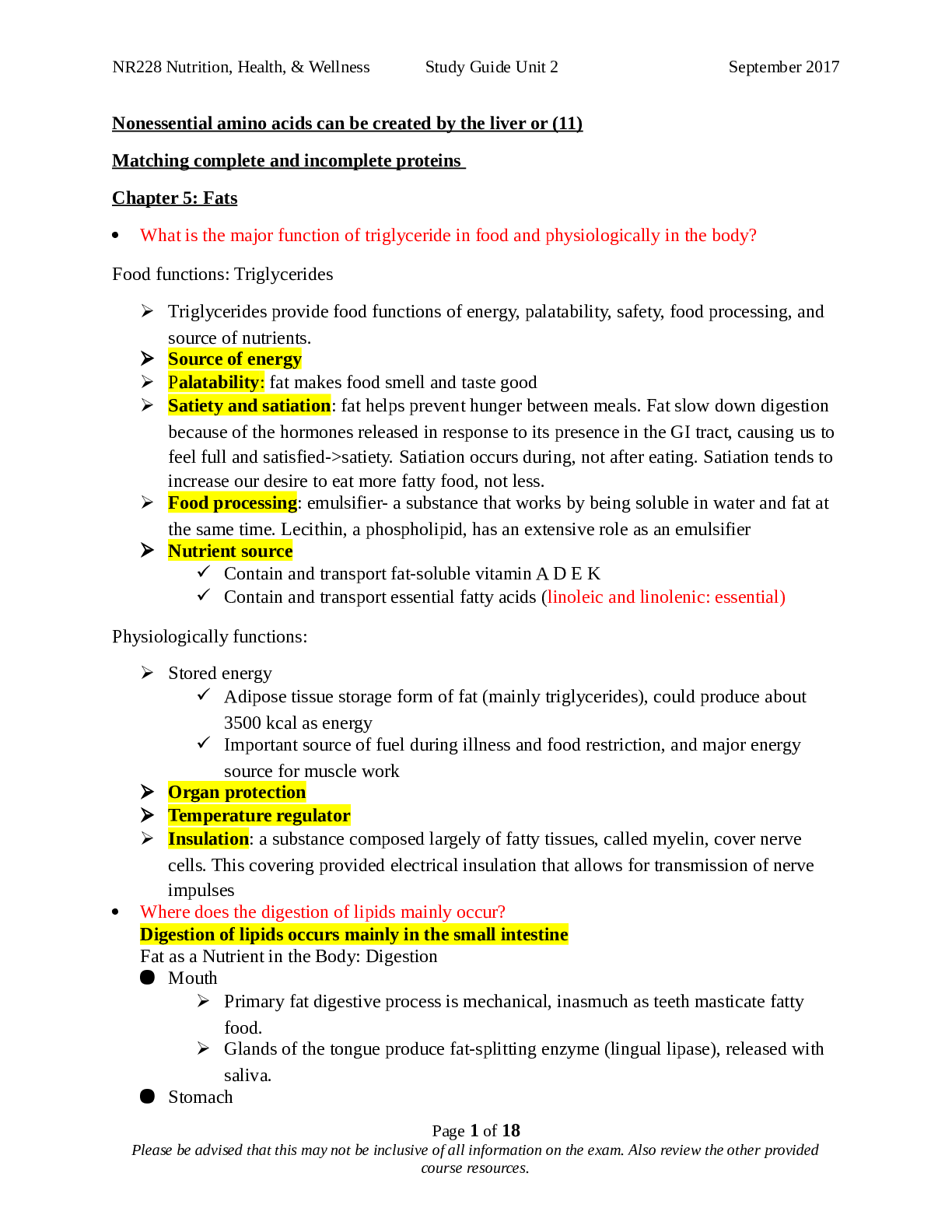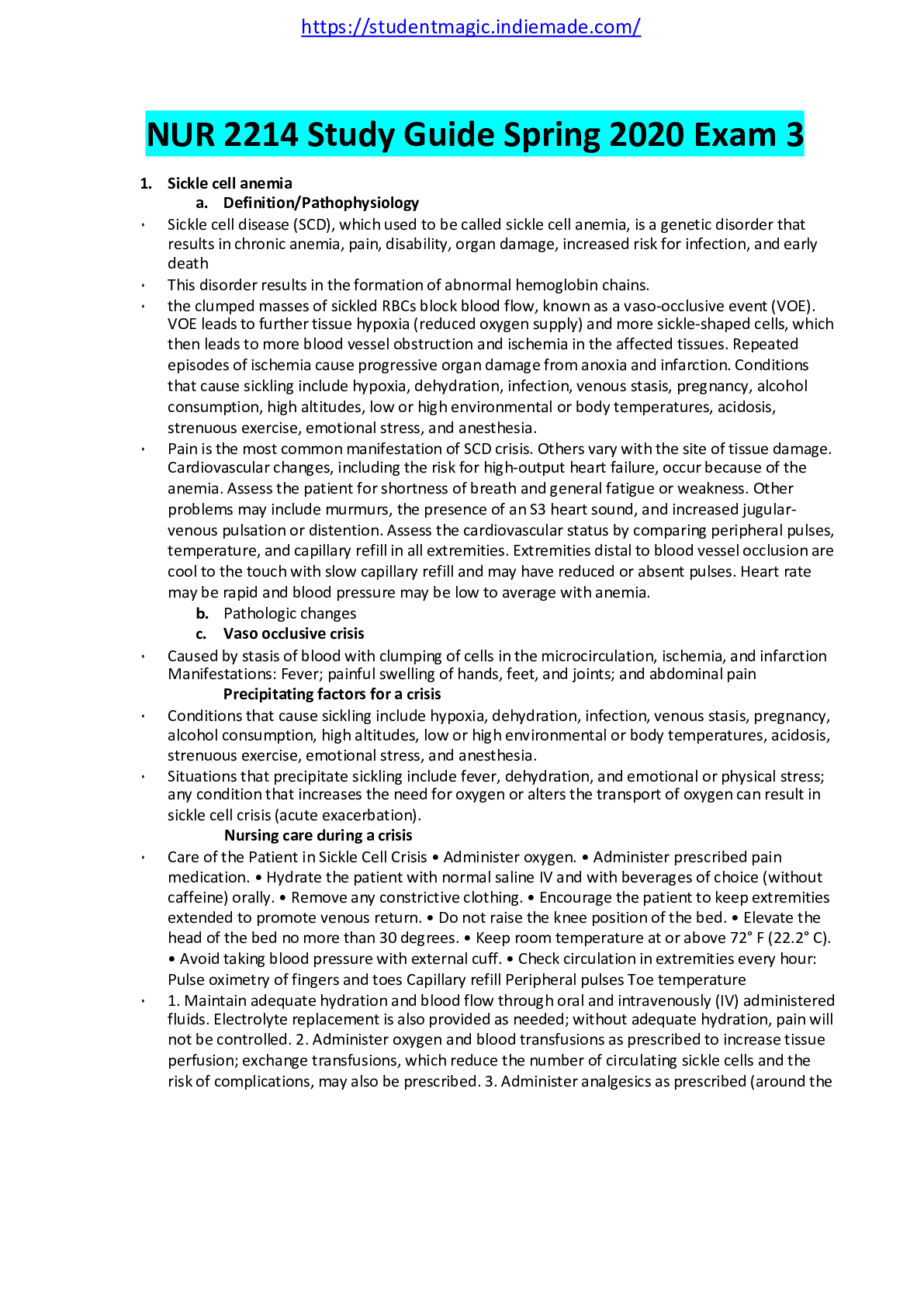*NURSING > STUDY GUIDE > NR 305 HESI QUESTIONS- EXAM REVIEW (All)
NR 305 HESI QUESTIONS- EXAM REVIEW
Document Content and Description Below
that the purpose of this medication is to A. Decrease production of gastric secretions. B. Produce an adherent barrier over the ulcer. C. Correct Maintain a gastric pH of 3.5 or above. D. Decrea... se gastric motor activity. 2. In evaluating the effects of lactulose (Cephulac), which outcome would indicate that the drug is performing as intended? A. An increase in urine output. B. Correct. Two or three soft stools per day. C. Watery, diarrhea stools D. Increased serum bilirubin. 3. The healthcare provider prescribes digitalis (Digoxin) for a client diagnosed with congestive heart failure. Which intervention should the nurse implement prior to administering the digoxin? The healthcare provider prescribes digitalis (Digoxin) for a client diagnosed with congestive heart failure. Which intervention should the nurse implement prior to administering the digoxin? a. Observe respiratory rate and depth. b. Correct Assess the serum potassium level. c. Obtain the client's blood pressure. d. Monitor the serum glucose level. 4. Following the administration of sublingual nitroglycerin to a client experiencing an acute anginal attack, which assessment finding indicates to the nurse that the desired effect has been achieved? A. Correct Client states chest pain is relieved. B. Client's pulse decreases from 120 to 90. C. Client's systolic blood pressure decreases from 180 to 90. D. Client's SaO2 level increases from 92% to 96%. 5. A client with congestive heart failure (CHF) is being discharged with a new prescription for the angiotensin-converting enzyme (ACE) inhibitor captopril (Capoten). The nurse's discharge instruction should include reporting which problem to the healthcare provider? A. Weight loss. B. Correct Dizziness. C. Muscle cramps. D. Dry mucous membranes. 6. A client is being treated for hyperthyroidism with propylthiouracil (PTU). The nurse knows that the action of this drug is to: A. Decrease the amount of thyroid-stimulating hormone circulating in the blood. B. Increase the amount of thyroid-stimulating hormone circulating in the blood. C. Increase the amount of T4 and decrease the amount of T3 produced by the thyroid. D. Inhibit synthesis of T3 and T4 by the thyroid gland. 7. A client with Parkinson's disease is taking carbidopa-levodopa (Sinemet). Which observation by the nurse would indicate that the desired outcome of the medication is being achieved? A. Decreased blood pressure. B. Correct Lessening of tremors. C. Increased salivation. D. Increased attention span. 8. Following heparin treatment for a pulmonary embolism, a client is being discharged with a prescription for warfarin (Coumadin). In conducting discharge teaching, the nurse advises the client to have which diagnostic test monitored regularly after discharge? A. Perfusion scan. B. Correct Prothrombin Time (PT/INR). C. Activated partial thromboplastin (APTT). D. Serum Coumadin level (SCL). 9. A postoperative client has been receiving a continuous IV infusion of meperidine (Demerol) 35 mg/hr for four days. The client has a PRN prescription for Demerol 100 mg PO q3h. The nurse notes that the client has become increasingly restless, irritable and confused, stating that there are bugs all over the walls. What action should the nurse take first? A. Administer a PRN dose of the PO meperidine (Demerol). B. Administer naloxone (Narcan) IV per PRN protocol. C. Correct Decrease the IV infusion rate of the meperidine (Demerol) per protocol. D. Notify the healthcare provider of the client's confusion and hallucinations. 10. A client is being treated for osteoporosis with alendronate (Fosamax), and the nurse has completed discharge teaching regarding medication administration. Which morning schedule would indicate to the nurse that the client teaching has been effective? A. Correct. Take medication, go for a 30 minute morning walk, and then eat breakfast. B. Take medication, rest in bed for 30 minutes, eat breakfast, go for morning walk. C. Take medication with breakfast, then take a 30 minute morning walk. D. Go for a 30 minute morning walk, eat breakfast, and then take medication. 11. A client is receiving metoprolol (Lopressor SR). What assessment is most important for the nurse to obtain? A. Temperature. B. Lung sounds. C. Correct Blood pressure. D. Urinary output. 12. A client with a dysrhythmia is to receive procainamide (Pronestyl) in 4 divided doses over the next 24 hours. What dosing schedule is best for the nurse to implement? A. Correct Q6h. B. QID. C. AC and bedtime. D. PC and bedtime. 13. Which action is most important for the nurse to implement prior to the administration of the antiarrhythmic drug adenosine (Adenocard)? A. Assess pupillary response to light. B. Instruct the client that facial flushing may occur. C. Correct Apply continuous cardiac monitoring. D. Request that family members leave the room. 14. A client has a continuous IV infusion of dopamine (Intropin) and an IV of normal saline at 50 ml/hour. The nurse notes that the client's urinary output has been 20 ml/hour for the last two hours. Which intervention should the nurse initiate? A. Stop the infusion of dopamine. B. Change the normal saline to a keep open rate. C. Replace the urinary catheter. D. Correct Notify the healthcare provider of the urinary output. 15. A client who was prescribed atorvastatin (Lipitor) one month ago calls the triage nurse at the clinic complaining of muscle pain and weakness in his legs. Which statement reflects the correct drug-specific teaching the nurse should provide to this client? A. Increase consumption of potassium-rich foods since low potassium levels can cause muscle spasms. B. Have serum electrolytes checked at the next scheduled appointment to assess hyponatremia, a cause of cramping. C. Correct Make an appointment to see the healthcare provider, because muscle pain may be an indication of a serious side effect. D. Be sure to consume a low-cholesterol diet while taking the drug to enhance the effectiveness of the drug. 16. Which nursing diagnosis is important to include in the plan of care for a client receiving the angiotensin-2 receptor antagonist Irbesartan (Avapro)? A. Fluid volume deficit. B. Risk for infection. C. Correct Risk for injury. D. Impaired sleep patterns. 17. A client is receiving clonidine (Catapres) 0.1 mg/24hr via transdermal patch. Which assessment finding indicates that the desired effect of the medication has been achieved? A. Client denies recent episodes of angina. B. Change in peripheral edema from +3 to +1. C. Client denies recent nausea or vomiting. D. Correct Blood pressure has changed from 180/120 to 140/70. 18. A client is receiving methylprednisolone (Solu-Medrol) 40 mg IV daily. The nurse anticipates an increase in which laboratory value as the result of this medication? A. Correct Serum glucose. B. Serum calcium. C. Red blood cells. D. Serum potassium. 19. An adult client has prescriptions for morphine sulfate 2.5 mg IV q6h and ketorolac (Toradol) 30 mg IV q6h. Which action should the nurse implement? A. Correct Administer both medications according to the prescription. B. Hold the ketorolac to prevent an antagonistic effect. C. Hold the morphine to prevent an additive drug interaction. D. Contact the healthcare provider to clarify the prescription. 20. A client's dose of isosorbide dinitrate (Imdur) is increased from 40 mg to 60 mg PO daily. When the client reports the onset of a headache prior to the next scheduled dose, which action should the nurse implement? A. Hold the next scheduled dose of Imdur 60 mg and administer a PRN dose of acetaminophen (Tylenol). B. Administer the 40 mg of Imdur and then contact the healthcare provider. C. Correct Administer the 60 mg dose of Imdur and a PRN dose of acetaminophen (Tylenol). D. Do not administer the next dose of Imdur or any acetaminophen until notifying the healthcare provider. 21. When assessing an adolescent who recently overdosed on acetaminophen (Tylenol), it is most important for the nurse to assess for pain in which area of the body? A. Flank. B. Correct Abdomen. C. Chest. D. Head. 22. Which antidiarrheal agent should be used with caution in clients taking high dosages of aspirin for arthritis? A. Loperamide (Imodium). B. Probanthine (Propantheline). C. Correct Bismuth subsalicylate (Pepto Bismol). D. Diphenoxylate hydrochloride with atropine (Lomotil). 23. The nurse is assessing the effectiveness of high dose aspirin therapy for an 88-year-old client with arthritis. The client reports that she can't hear the nurse's questions because her ears are ringing. What action should the nurse implement? A. Refer the client to an audiologist for evaluation of her hearing. B. Advise the client that this is a common side effect of aspirin therapy. C. Correct Notify the healthcare provider of this finding immediately. D. Ask the client to turn off her hearing aid during the exam. 24. The nurse is reviewing the use of the patient-controlled analgesia (PCA) pump with a client in the immediate postoperative period. The client will receive morphine 1 mg IV per hour basal rate with 1 mg IV every 15 minutes per PCA to total 5 mg IV maximally per hour. What assessment has the highest priority before initiating the PCA pump? A. The expiration date on the morphine syringe in the pump. B. Correct The rate and depth of the client's respirations. C. The type of anesthesia used during the surgical procedure. D. The client's subjective and objective signs of pain. 25. The healthcare provider prescribes naloxone (Narcan) for a client in the emergency room. Which assessment data would indicate that the naloxone has been effective? The client's: A. Statement that the chest pain is better. B. Correct Respiratory rate is 16 breaths/minute. C. Seizure activity has stopped temporarily. D. Pupils are constricted bilaterally. 26. A client is admitted to the hospital for diagnostic testing for possible myasthenia gravis. The nurse prepares for intravenous administration of edrophonium chloride (Tensilon). What is the expected outcome for this client following administration of this pharmacologic agent? A. Progressive difficulty with swallowing. B. Decreased respiratory effort. C. Improvement in CONTINUED,.........DOWNLOAD FOR BEST SCORES [Show More]
Last updated: 1 year ago
Preview 1 out of 12 pages

Reviews( 0 )
Document information
Connected school, study & course
About the document
Uploaded On
Jun 11, 2022
Number of pages
12
Written in
Additional information
This document has been written for:
Uploaded
Jun 11, 2022
Downloads
0
Views
37

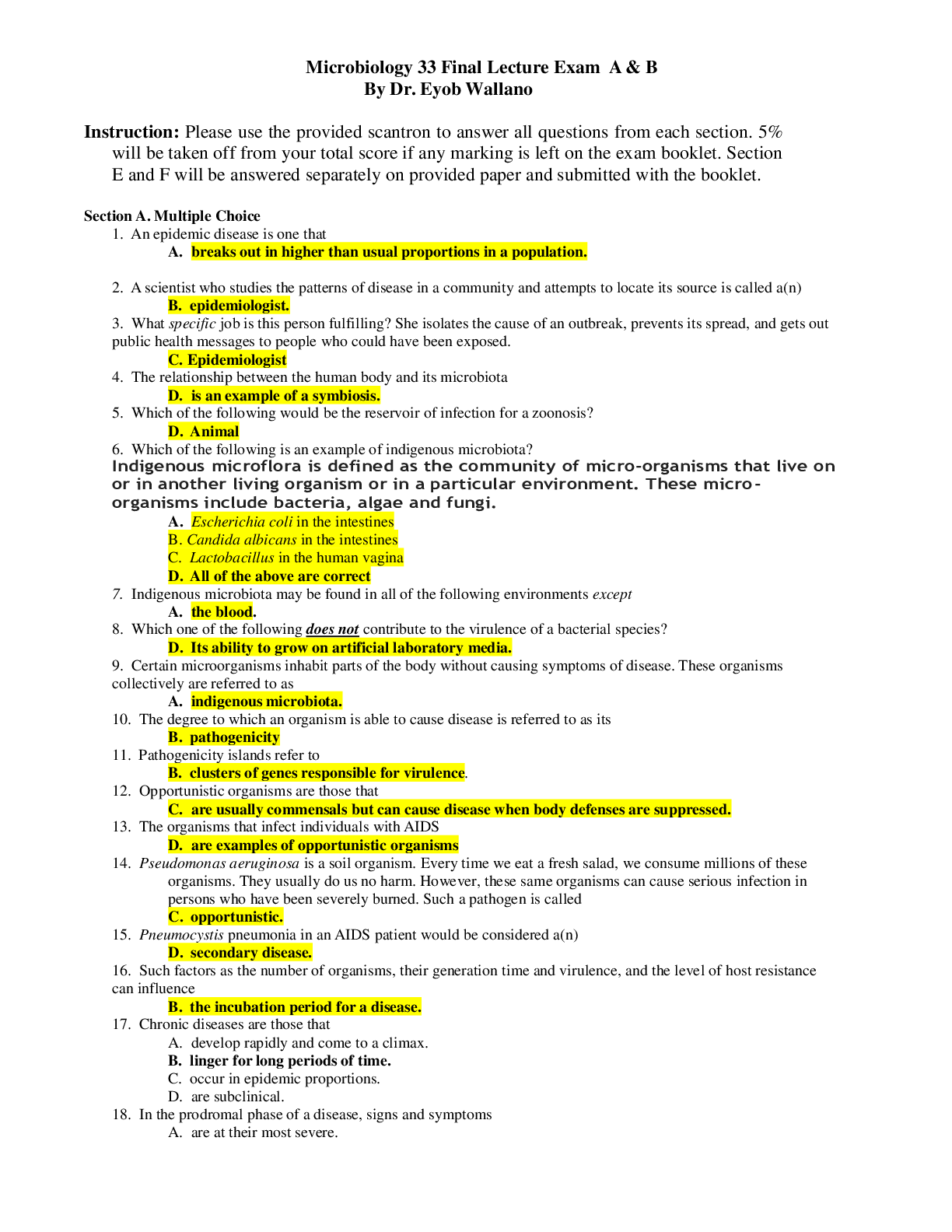
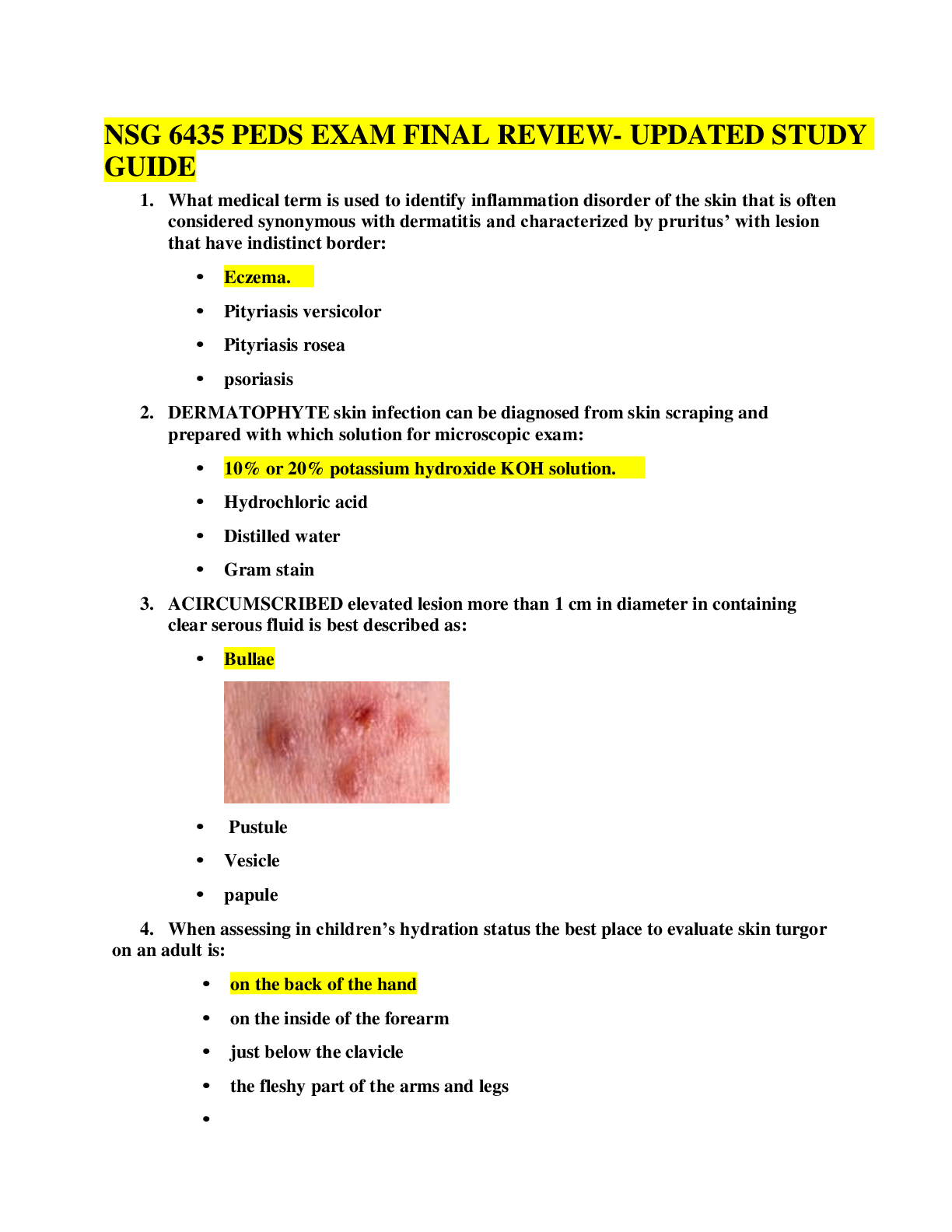



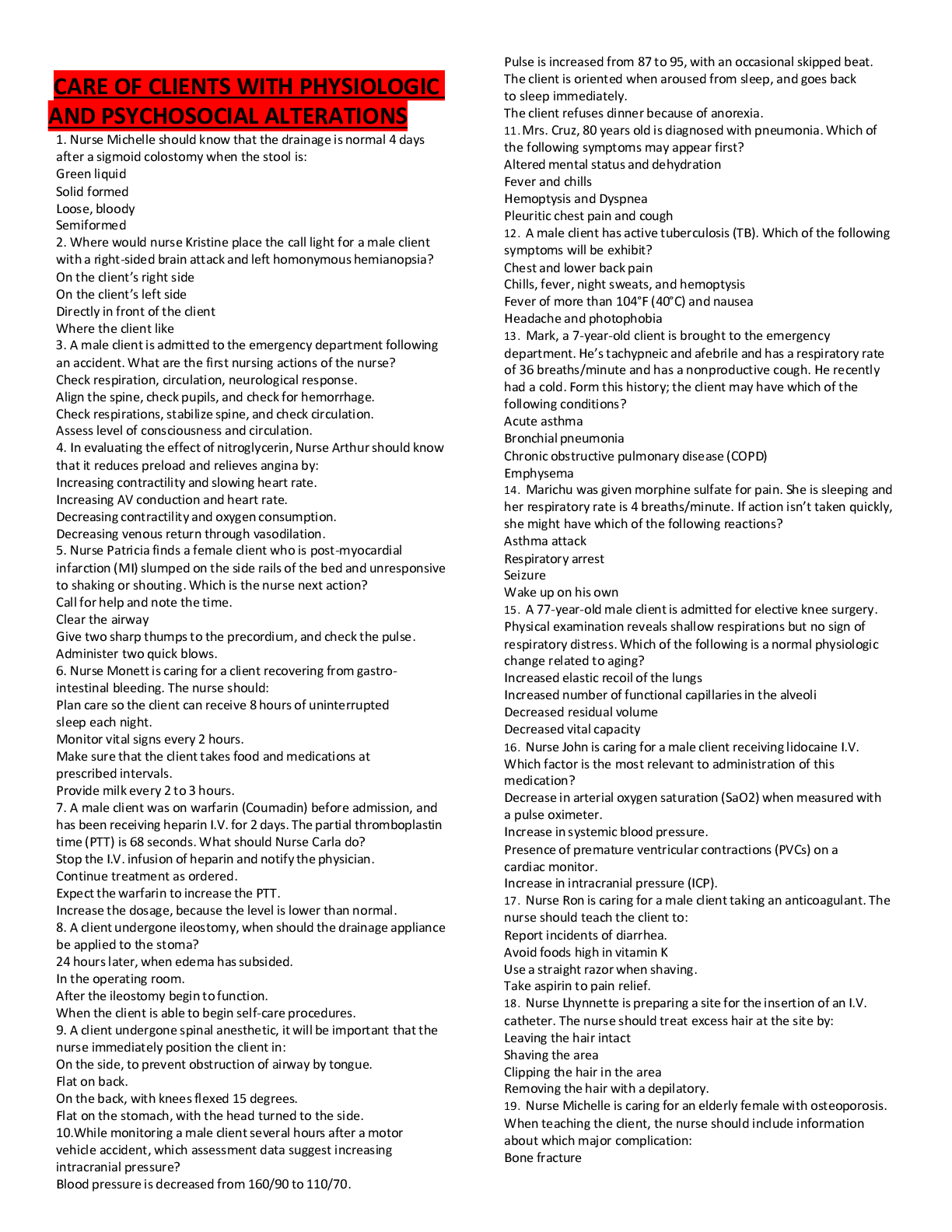



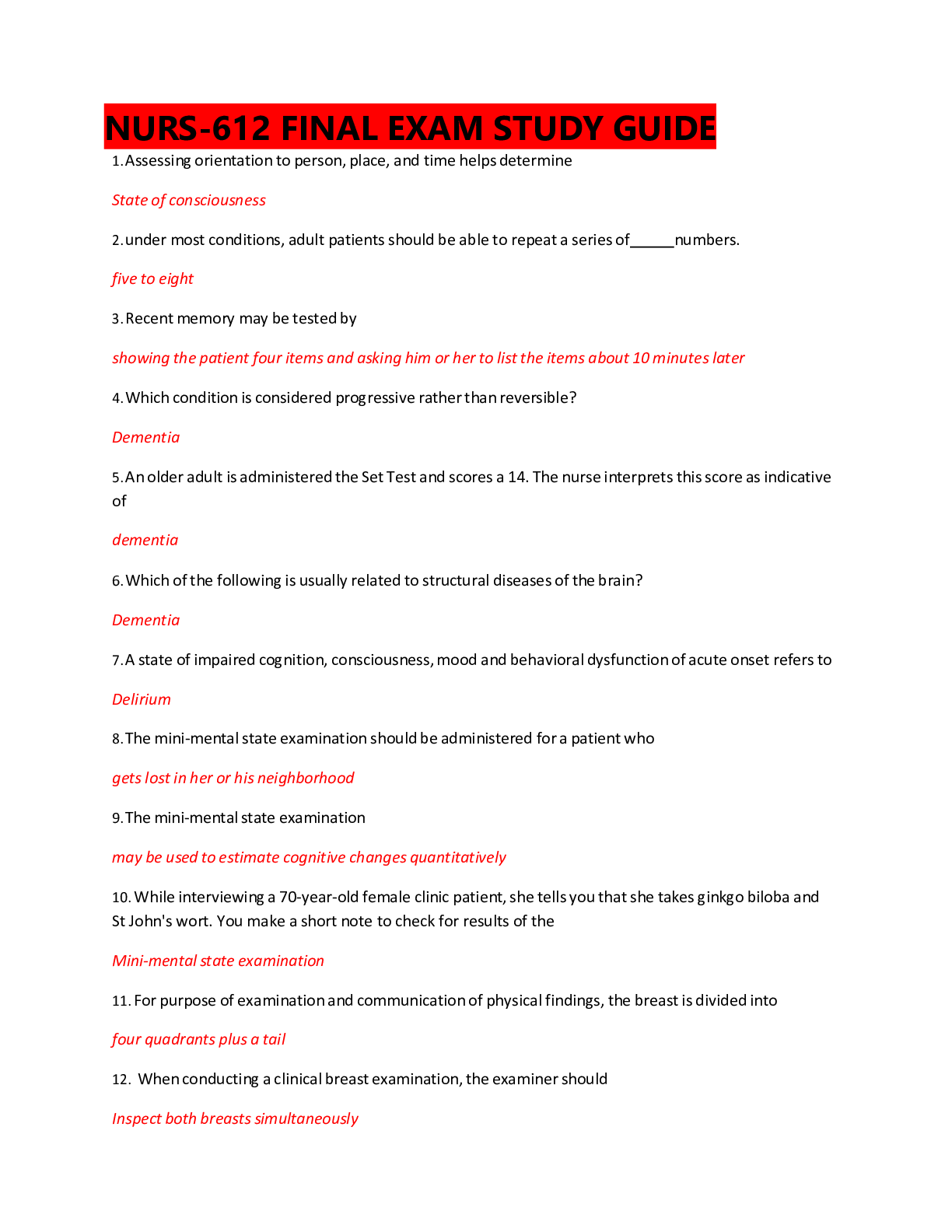
 BMAL 590- QUANTITATIVE RESEARCH TECHNIQUES AND STATISTICS TEST WITH SUMMARIZED STUDY GUIDE.png)
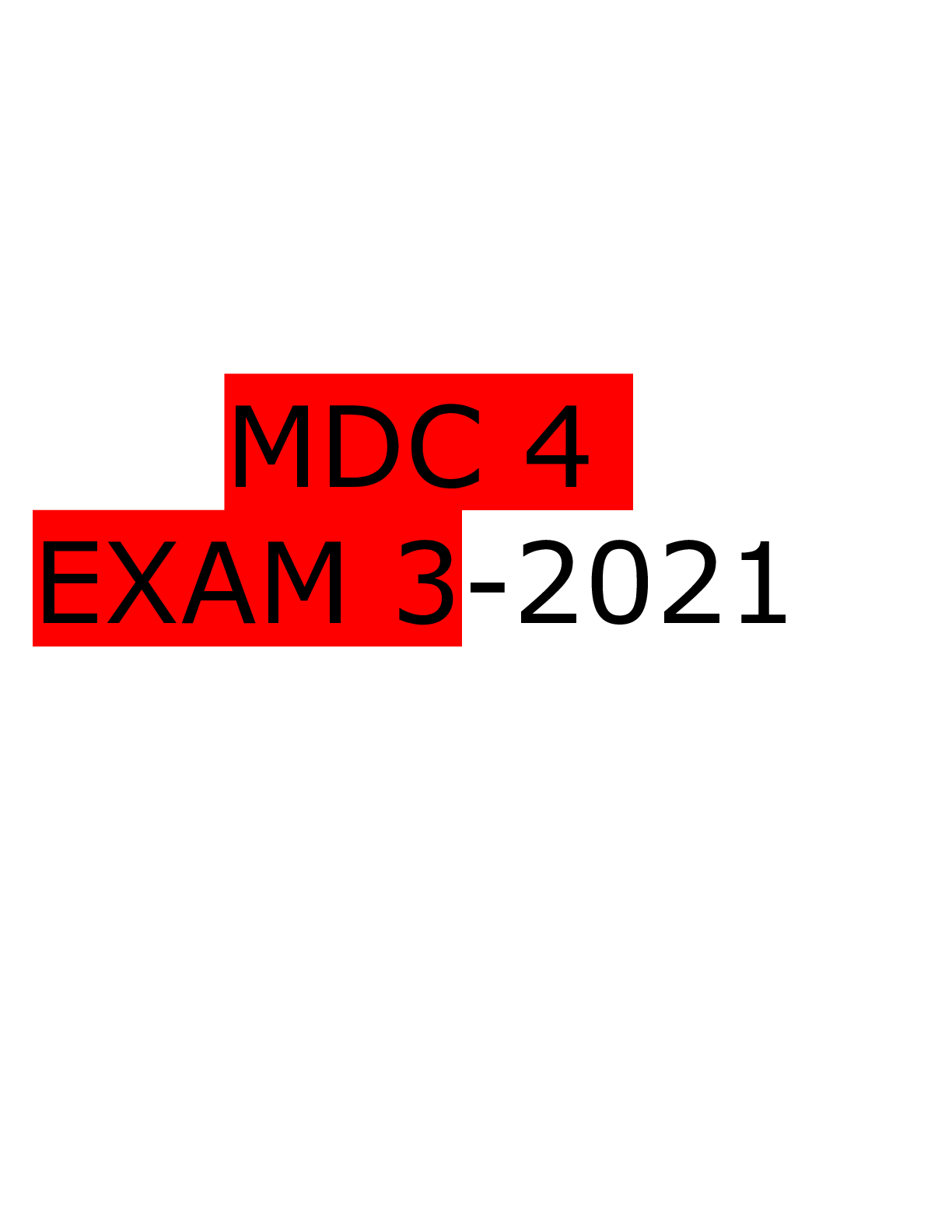
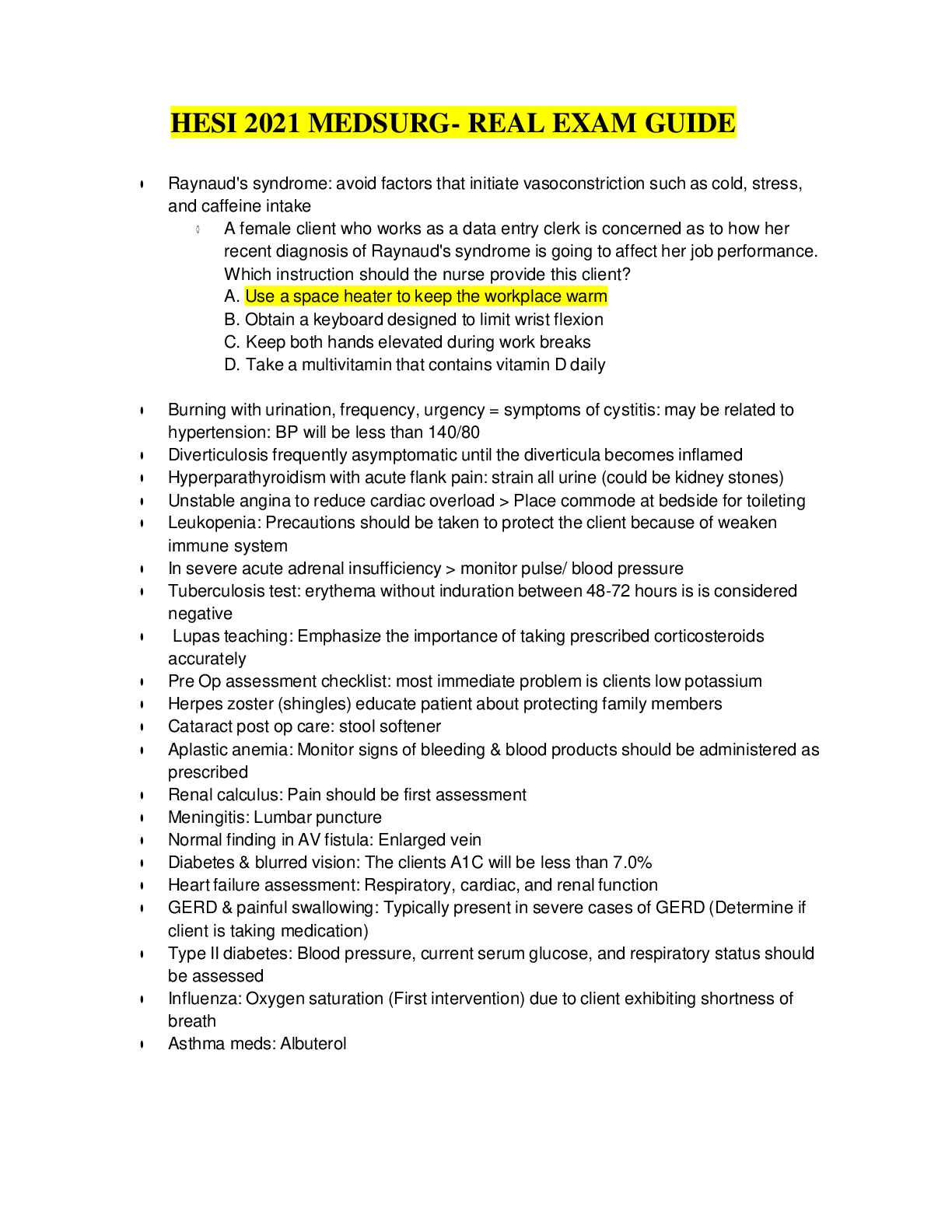









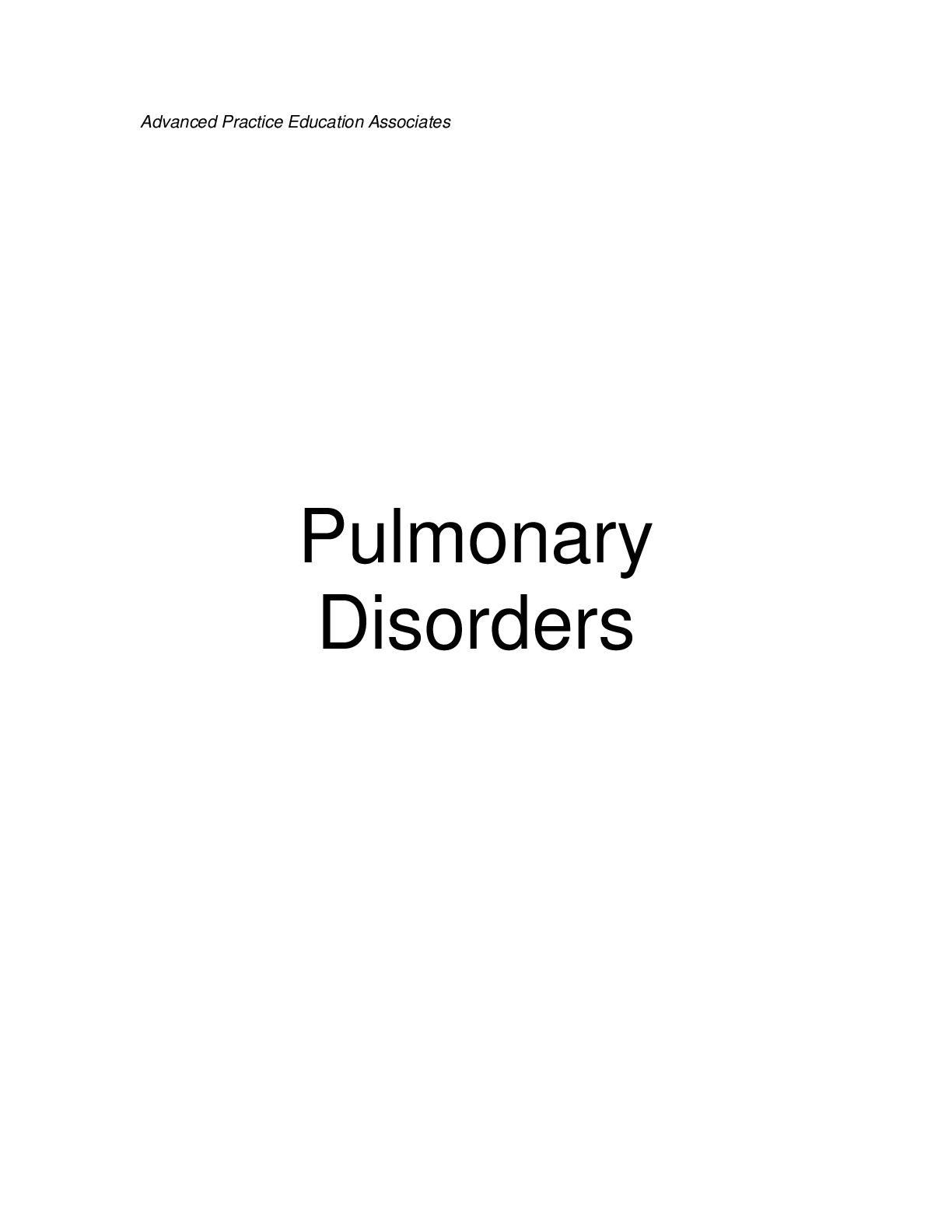
.png)





